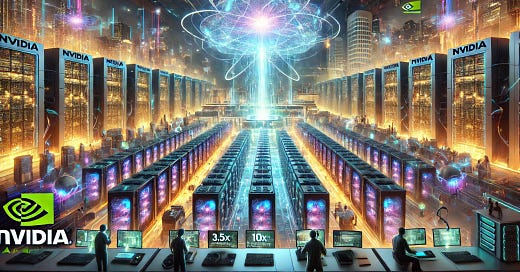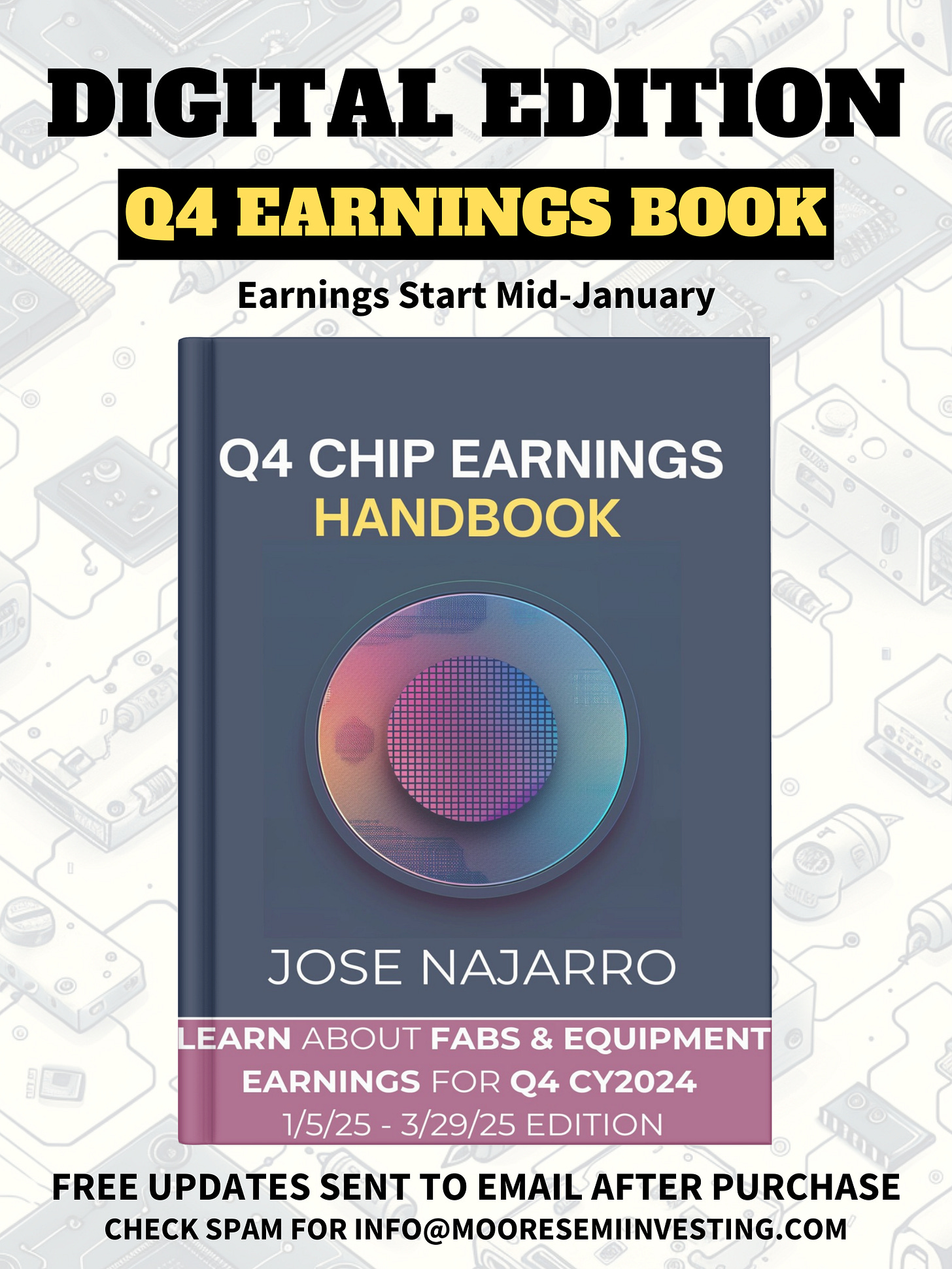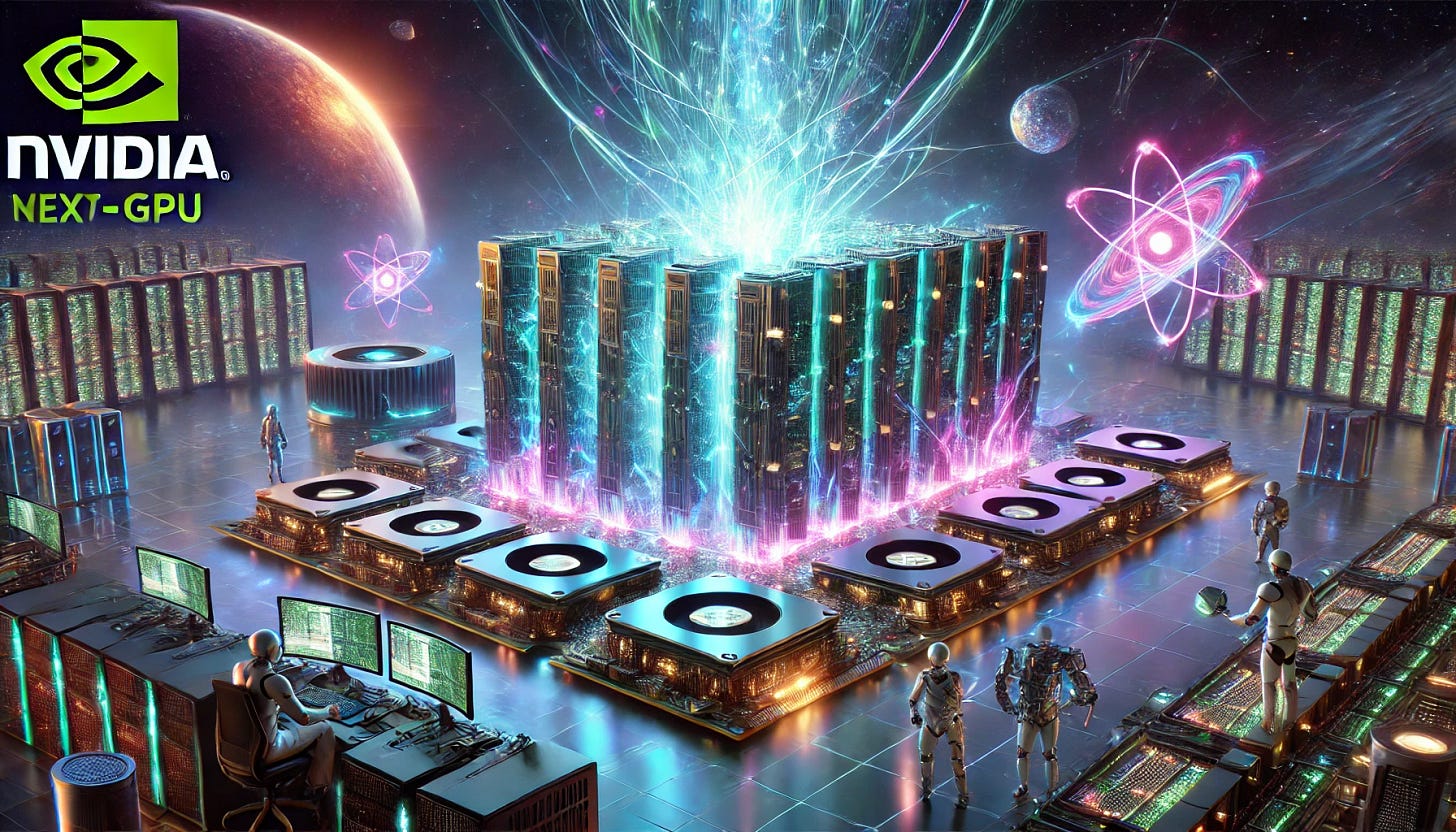🚀 Photonics-Powered Leap: NVIDIA’s Switch to AI Megafactories
Welcome, AI & Semiconductor Investors,
NVIDIA's launch of Spectrum-X and Quantum-X Photonics switches marks a photonics-powered revolution in AI data centers, promising massive energy savings and a leap in scalability for next-gen AI megafactories.
We also dive into NVIDIA’s new Dynamo software, set to dramatically accelerate AI inference, and the ambitious "Vera Rubin" CPU-GPU architecture that's meant to redefine AI performance. — Let’s Chip In
What The Chip Happened?
🚀 Photonics-Powered Leap: NVIDIA’s Switch to AI Megafactories
⚡ Nvidia Dynamo Powers AI Factories
📈 Rubin & Vera: NVIDIA’s Big Leap Forward
[NVIDIA’s GTC Spotlight: New “Blackwell” GPUs and an AI-Driven Future]
Read time: 7 minutes
NVIDIA (NASDAQ: NVDA)
🚀 Photonics-Powered Leap: NVIDIA’s Switch to AI Megafactories
What The Chip: NVIDIA just announced on March 18, 2025, its Spectrum-X Photonics and Quantum-X Photonics networking switches. These co-packaged optics solutions aim to connect millions of GPUs at lower energy costs, with 3.5x greater power efficiency and 10x better network resilience.
Details:
🔌 Co-Packaged Optics: NVIDIA’s new switches fuse electrical and optical tech on a single package, cutting out bulky transceivers. Jensen Huang, CEO of NVIDIA, said they’re “shattering the old limitations” to support AI factories at million-GPU scales.
🔋 Energy and Cost Savings: By using microring resonator (MRM) modulators, NVIDIA claims 3.5x more power efficiency than traditional solutions. According to Huang, ditching standalone 30W optical modules could save tens of megawatts per data center.
🌐 Massive Throughput: Spectrum-X Photonics Ethernet switches offer up to 400 terabits per second and Quantum-X Photonics InfiniBand switches can deliver 2x faster speeds than the previous generation, with up to 144 ports of 800Gb/s each.
⚙️ Key Collaborations: TSMC, Foxconn, Corning, and others are providing manufacturing and supply-chain support. “A new wave of AI factories requires efficiency,” said C. C. Wei, CEO of TSMC.
🔄 Scalability for AI Factories: NVIDIA’s approach aims to ease the connection of GPUs across stadium-sized data centers. Huang highlighted that conventional transceivers could add up to 180 watts per GPU if you scale to hundreds of thousands of GPUs — a cost these new switches hope to slash.
🛠 Rollout Timeline: Quantum-X InfiniBand versions are expected later this year, with Spectrum-X Photonics Ethernet arriving in 2026, allowing industry players time to prepare for broad deployment.
⚖️ Potential Hurdles: Although cutting-edge, co-packaged optics involve complex manufacturing and licensing. Investors should watch for any supply-chain bottlenecks or cost overruns as volumes ramp.
Why AI/Semiconductor Investors Should Care: As generative AI and large-scale model training explode, data centers face escalating energy and connectivity challenges. NVIDIA’s photonics-based switches aim to solve these issues, potentially boosting AI productivity while lowering operational costs. For investors, this could signal both a major revenue driver for NVIDIA and a vital tech leap for an industry racing to build next-gen AI infrastructure.
Moore Semiconductor Investing
📗 [NEW!!] Unlock Q4 Semiconductor Earnings --- 60% OFF (NEW EARNINGS)
What The Chip: Get a front-row seat to the financials shaping the semiconductor industry. This continuously updated e-book by Jose Najarro distills the latest Q4 quarterly insights—from wafer production trends to AI chip breakthroughs—into a single comprehensive resource.
Details:
🔵 Dynamic Updates: Start with giants like TSMC and ASML, then expand to 30+ companies as their Q4 2024 earnings roll in. Earnings are restarting!!
🔵 Broad Coverage: From traditional chipmakers to cutting-edge AI semiconductor players, get the full picture as it emerges.
Why AI/Semiconductor Investors Should Care: This evolving earnings handbook gives you a strategic edge. Understanding quarterly earnings data is crucial for gauging industry health, discovering new growth leaders, and aligning your investment approach with emerging technological waves.
Disclaimer: For educational and informational purposes only. Not financial advice. Consult with a qualified professional before making any investment decisions. Updates are only for the Quarter of Earnings.
NVIDIA (NASDAQ: NVDA)
⚡ Nvidia Dynamo Powers AI Factories
What The Chip: NVIDIA just unveiled Dynamo on March 18, 2025—a new open-source inference software that orchestrates and accelerates reasoning models at scale. This next-gen platform is designed to reduce AI serving costs while doubling performance for LLMs on the Hopper GPU family.
Details:
⚡ AI "Operating System": Jensen Huang, NVIDIA’s CEO, called Dynamo “essentially the operating system of an AI factory,” enabling dynamic GPU allocation, advanced routing, and disaggregated serving of LLM workloads.
🤖 Token Throughput Gains: According to NVIDIA, Dynamo can boost token generation by over 30x per GPU for large language models like DeepSeek-R1, significantly increasing revenue potential for AI service providers.
💡 Smarter GPU Allocation: A built-in planner can dynamically reassign GPUs in response to shifting inference loads. This helps prevent wasteful over-provisioning and minimizes underused resources.
📚 Disaggregated Serving: By splitting the LLM’s processing (query understanding) and generation (token decoding) phases across different GPUs, Dynamo gets the most out of each GPU’s strength.
🔌 Cost-Saving Offloading: Dynamo’s memory manager automatically offloads data to cheaper storage tiers—without sacrificing performance—cutting inference costs for large-scale deployments.
🔓 Fully Open Source: Dynamo works with PyTorch, SGLang, TensorRT-LLM, and vLLM, giving enterprises and researchers flexibility to build and optimize AI services across disaggregated hardware.
🏭 Partner Adoption: Cohere, Perplexity AI, and Together AI are among partners embracing Dynamo for large-scale, agentic AI solutions. NVIDIA reports that Dynamo effectively doubles performance for Llama-based workloads on today’s Hopper platform.
Why AI/Semiconductor Investors Should Care: Dynamo’s ability to optimize massive multi-GPU inference directly impacts AI factory revenue and margins, making it a strategic advantage in the growing LLM ecosystem. As inference workloads balloon, the cost and efficiency benefits of Dynamo could be pivotal for providers—and a potential driver of adoption for NVIDIA’s next-gen GPUs.
NVIDIA (NASDAQ: NVDA)
📈 Rubin & Vera: NVIDIA’s Big Leap Forward
What The Chip: NVIDIA just revealed detailed plans (announced recently by CEO Jensen Huang) for its next-gen CPU-GPU platform, codenamed “Vera Rubin.” Named after the astronomer Vera Rubin (who discovered evidence of dark matter), this new architecture promises massive performance leaps in both compute and bandwidth—all at surprisingly lower power consumption.
Details:
🔍 New CPU, New GPU: The Vera Rubin platform pairs a “tiny 50-watt” CPU (roughly double the performance of Grace) with a “Rubin” GPU, brand-new CX9 networking, and NVLink 6 interconnect for a completely revamped system.
⚡ Scaling Up and Out: Vera Rubin will operate with an NVLink “144” design, meaning it can connect up to 144 individual GPU dies, significantly boosting scale-up capabilities before eventually expanding scale-out options.
💼 Power vs. Performance: According to Jensen Huang, Vera Rubin aims to reduce cost and power consumption dramatically. He highlighted that power efficiency (watts divided by FLOPS x bandwidth) will improve “tremendously.”
📈 Rubin Ultra in 2027: Looking even further, NVIDIA plans a “Rubin Ultra” in the second half of 2027, targeting 15 exaflops of performance (up from 1 exaflop) and boasting 600 kilowatt racks and 2.5 million parts. With Vera Rubin Ultra NVL 576
🌐 Networking Advances: With CX9 and Spectrum-X technologies, NVIDIA is pushing Ethernet to be more InfiniBand-like in terms of low-latency and congestion control. This sets the foundation for “extreme scale-up” and helps enterprises incorporate AI seamlessly.
🧩 Simplifying the Terminology: Jensen Huang acknowledged a “mistake” in naming each chip “a GPU” in the Blackwell generation. Going forward, the naming and NVLink references become more consistent, clarifying how multiple GPU dies can exist in a single package.
💬 CEO’s Confidence: “Rubin Ultra is going to drive the cost down tremendously,” said Jensen Huang, emphasizing that once-a-year platform ticks are now the expected cadence for NVIDIA’s roadmap.
Why AI/Semiconductor Investors Should Care: NVIDIA’s rapid succession of CPU-GPU platforms underscores its commitment to leading both the AI and HPC space. The Vera Rubin launch, along with its future “Rubin Ultra,” signals significant headroom for performance growth, efficiency gains, and enterprise networking opportunities. For investors, these new architectures reinforce NVIDIA’s position at the forefront of AI infrastructure, potentially driving long-term demand and market share gains.
Youtube Channel - Jose Najarro Stocks
[NEW] Semiconductor Q4 Earnings Book — 60% OFF
X Account - @_Josenajarro
Disclaimer: This article is intended for educational and informational purposes only and should not be construed as investment advice. Always conduct your own research and consult with a qualified financial advisor before making any investment decisions.
The overview above provides key insights every investor should know, but subscribing to the premium tier unlocks deeper analysis to support your Semiconductor, AI, and Software journey. Behind the paywall, you’ll gain access to in-depth breakdowns of earnings reports, keynotes, and investor conferences across semiconductor, AI, and software companies. With multiple deep dives published weekly, it’s the ultimate resource for staying ahead in the market. Support the newsletter and elevate your investing expertise—subscribe today!
[Paid Subscribers] NVIDIA’s GTC Spotlight: New “Blackwell” GPUs and an AI-Driven Future
Executive Summary
*Reminder: We do not talk about valuations, just an analysis of the earnings/conferences
NVIDIA (NASDAQ: NVDA) showcased a sweeping array of advancements at its latest GPU Technology Conference (GTC). Company leaders looked into how artificial intelligence (AI) workloads are expanding significantly, driving heavier adoption of accelerated computing solutions. Key highlights included the unveiling of the next-generation “Blackwell” graphics processing units (GPUs), an expanded roadmap through 2027, deeper enterprise AI offerings, and a bold new focus on robotics solutions. During the conference, CEO Jensen Huang underscored the persistent surge in AI computational requirements, stating, “The computation requirement…is easily 100 times more than we thought we needed this time last year.” Together with strong demand from hyperscale data centers and the broader enterprise market, NVIDIA’s recent announcements reflect a strategic push to stay at the forefront of data-driven, accelerated computing.
Below are the main takeaways from NVIDIA’s event, including an overview of the company’s product roadmap, data center business growth, and opportunities in robotics. Additionally, we’ll review headwinds the company may face in this rapidly evolving environment, as well as a closer look at NVIDIA’s operating trends and strategic outlook.
Growth Opportunities
Scaling Data Center Acceleration
A key theme from the GTC event was NVIDIA’s confidence in the expansion of large-scale AI factories. Management anticipates that, going forward, customers will dedicate substantial capital to upgrade their data centers with high-performance GPUs. “I expect data center build out to reach one trillion dollars…and I am fairly certain we’re going to reach that very soon,” Huang remarked, pointing to the increasing complexity of AI models. This shift drives a massive addressable market for NVIDIA’s GPU-accelerated hardware and software stacks, especially in inference (i.e., the real-time generation of AI outputs).







